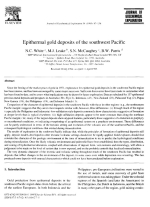Добрый день, Коллеги. Важное сообщение, просьба принять участие. Музей Ферсмана ищет помощь для реставрационных работ в помещении. Подробности по ссылке
Epithermal gold deposits of the southwest Pacific / Эпитермальные золоторудные месторождения юго-западной Пацифики
Since the freeing of the market price of gold in 1971. exploration for epithermal gold deposits in the southwest Pacific region has been intense, and has been encouraged by some major successes. Sufficient discoveries have been made to summarise what has been found to date, and to assess what implications may be drawn for future exploration. Data are tabulated for 137 epithermal precious metal deposits and prospects in Australia (30), Fiji (2). Indonesia (43 ). New Zealand (22), Palau and Yap (2), Papua New Guinea (18), the Philippines (19), and Solomon Islands (1).
Comparison of the character of epithermal deposits in the southwest Pacific with those in other regions (e.g., the northeastern Pacific margin) suggests that they are in most respects similar with, however, three differences: (i) through much of the region (especially the Philippines and Indonesia) low-sulfidation style deposits commonly show characteristics suggestive of formation at deeper levels than is typical elsewhere; (ii) high-sulfidation deposits appear to be more common than along the northeast Pacific margin; (iii) many of the largest deposits show atypical features, particularly those suggestive of a transition to porphyry or mesothermal conditions, or indicating overprinting of an epithermal system on a porphyry environment. These differences can be partly understood in terms of the tectonic setting and evolution of the volcanic arcs of the southwest Pacific, and the consequent hydrological conditions that existed during mineralization.
The results of exploration in the southwest Pacific indicate that, while the principles of formation of epithermal deposits still apply, deposit models developed in other tectonic/volcanic settings should not be rigidly applied. Gold explorers should first consider the character of the geologic environment at the time of mineralization to try to predict the hydrological conditions during mineralization. Once the likely volcanic environment and paleorelief have been established, then the types, distribution, and zoning of hydrothermal alteration, coupled with observations of deposit form, vein textures and mineralogy, will allow a judgement to be made on the level of system that is now exposed, and on the probable controls that localized mineralization.
The very dynamic character of the tectonic and volcanic setting throughout much of the southwest Pacific has resulted in deposits that reflect changes in the environment of the deposit, in some cases even while deposition was occurring. This has produced some deposits with unusual characteristics which could not have been predicted before exploration.




